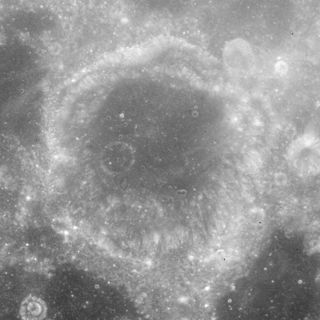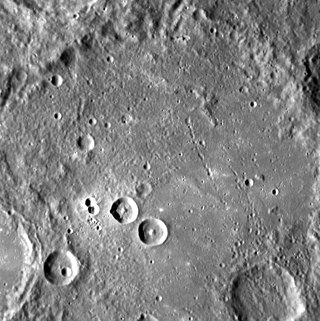
Ansgarius is a lunar impact crater that is located near the eastern limb of the Moon. When viewed from the Earth, the crater has a highly oval shape due to foreshortening, but the rim is actually nearly circular. To the northwest of Ansgarius is the crater La Pérouse, and south is Behaim.

Apollo, also called the Apollo basin, is an enormous impact crater located in the southern hemisphere on the far side of the Moon. This formation dwarfs the large crater Oppenheimer that is located next to the western rim. The crater Barringer lies across the northern wall. To the southeast is the crater Anders, and Kleymenov is just to the east of the rim.

Fechner is a lunar impact crater that lies on the far side of the Moon's southern hemisphere, attached to the western rim of the large walled plain Planck. The eastern rim of Fechner intersects the Vallis Planck, a long, wide cleft in the surface that follows a course to the north-northwest. This valley intrudes into the southeastern rim of the crater, then continues northwards from the periphery of the northeast rim.

Fabry is a large lunar impact crater of the form termed a walled plain. It is located on the far side of the Moon, just beyond the northeastern limb. Parts of this area are sometimes brought into view by the effects of libration, but the terrain is seen from the edge and so not much in the way of detail can be observed.

Bečvář is a lunar impact crater that is located near the equator on the far side of the Moon. It lies to the northeast of the crater Necho, within that feature's ray system. To the north-northeast is the crater Gregory.

Cusanus is a lunar impact crater that is located near the northeastern limb of the Moon. In this location the crater appears very foreshortened when observed from the Earth, and its visibility is affected by libration. The northern rim of Cusanus is nearly joined to the south-southeastern rim of the larger crater Petermann. To the west is Baillaud and to the southeast is Hayn.

Dubyago is a lunar impact crater that lies in the eastern limb of the Moon. It was named after Russian astronomers Dmitry Dubyago and Alexander Dubyago. It appears significantly foreshortened when viewed from the Earth. It lies along the southern shore of the Mare Undarum, to the southeast of the crater Firmicus.

Fermi is a large lunar impact crater of the category named a walled plain. It was named after Italian-American physicist and Nobel laureate Enrico Fermi. It lies on the far side of the Moon and can not be viewed from the Earth. Thus this feature must be viewed from an orbiting spacecraft.

Chrétien is a lunar impact crater that is located in the southern hemisphere on the far side of the Moon from the Earth. It lies due south of the Mare Ingenii, one of the few maria on the Moon's far side. The crater lies in the midpoint between the craters Garavito to the west-southwest and Oresme to the east-northeast, both of these being somewhat smaller than Chrétien.

Davisson is a lunar impact crater that is located on the far side of the Moon from the Earth. This crater lies across the eastern rim of the huge walled plain Leibnitz, and the rim and outer rampart intrudes into the interior floor of Leibnitz. To the east-northeast of Davisson is the walled plain Oppenheimer, a formation only somewhat smaller than Leibnitz.

Carnot is a large crater in the northern part of the Moon's far side. It was named after Nicolas L. S. Carnot by the IAU in 1970.

Ibn Firnas is a lunar impact crater on the far side of the Moon. Attached to the exterior of its southwestern rim is the prominent crater King. Only a few kilometers to the north, separated by a rugged stretch of terrain, is the larger crater Ostwald.

Dellinger is a lunar impact crater that is located on the Moon's far side. It is attached to the southern rim of the crater Pannekoek. To the southeast lies the crater Marconi, and to the southwest is Chauvenet.

Fleming is a large lunar impact crater that is located on the Moon's far side, and cannot be seen from the Earth. It lies about a crater diameter to the east-northeast of Hertz, and to the northwest of Lobachevskiy.

Matisse is an impact crater on the southern hemisphere of Mercury. Matisse takes its name from the French artist Henri Matisse, and it was named by the IAU in 1976.

Mendes Pinto is a crater on Mercury. Its name was adopted by the International Astronomical Union (IAU) in 1976. Mendes Pinto is named for the Portuguese adventurer Fernão Mendes Pinto, who lived from 1510 to 1583.

Karsh is a crater on Mercury. It has a diameter of 58 kilometers. Its name was suggested by American resident Elizabeth Freeman Rosenzweig in a naming contest which was eventually adopted by the International Astronomical Union (IAU) on 2015. Karsh is named for the Armenian-Canadian photographer Yousuf Karsh. The craters Carolan, Enheduanna, Kulthum, and Rivera were also named as part of the contest.

Anguissola is a crater on Mercury. It has a diameter of 35.41 kilometres. Its name was adopted by the International Astronomical Union (IAU) on August 4, 2017. Anguissola is named for the Italian painter Sofonisba Anguissola.

Pushkin is a crater on Mercury. Its name was adopted by the International Astronomical Union (IAU) in 1976. Pushkin is named for Russian poet Alexander Pushkin.




















